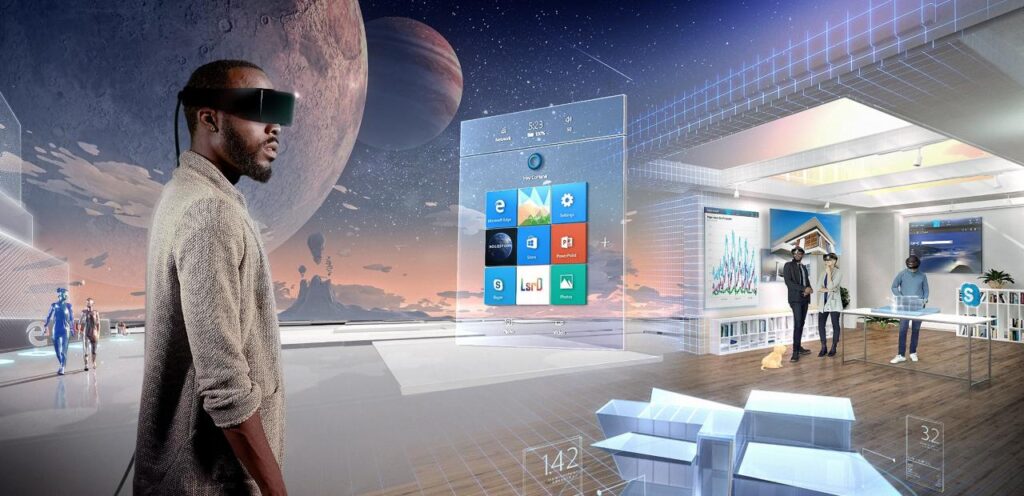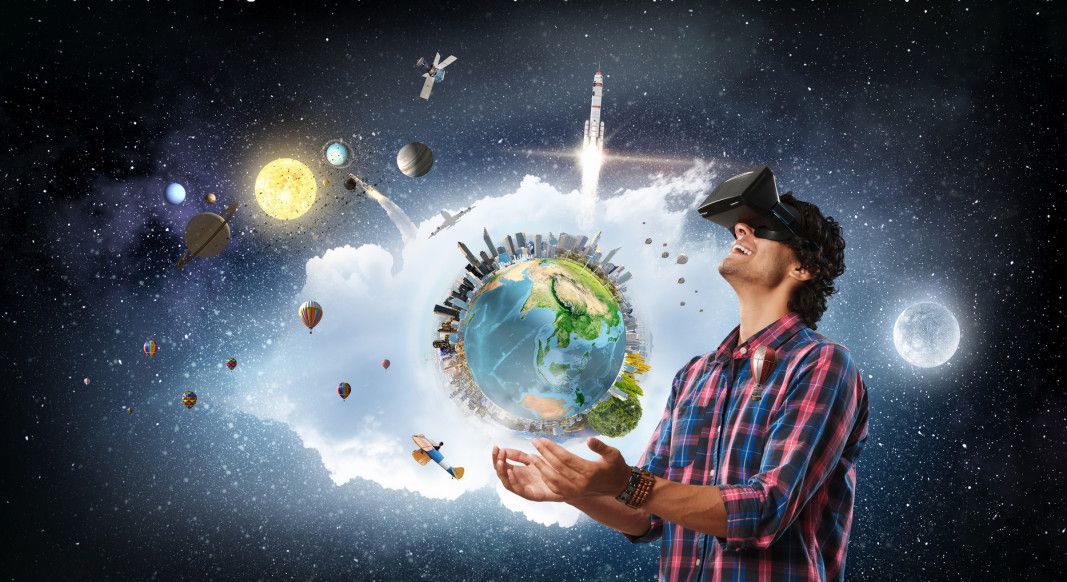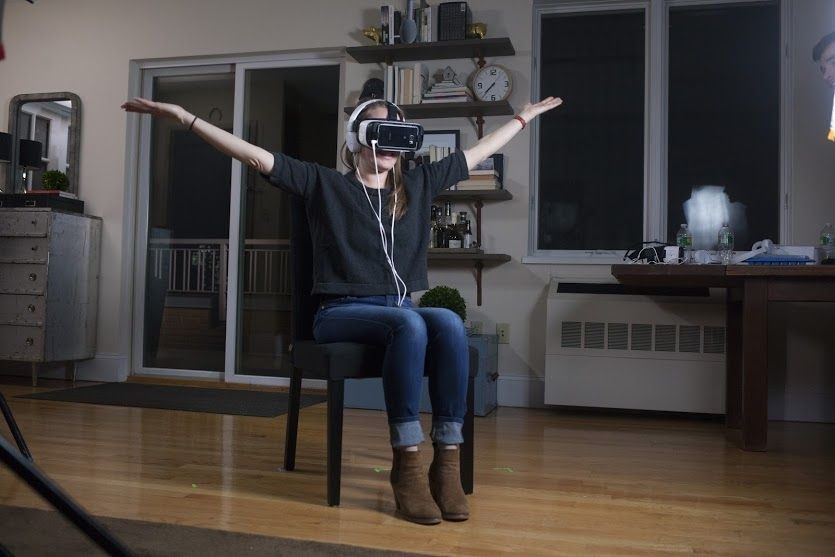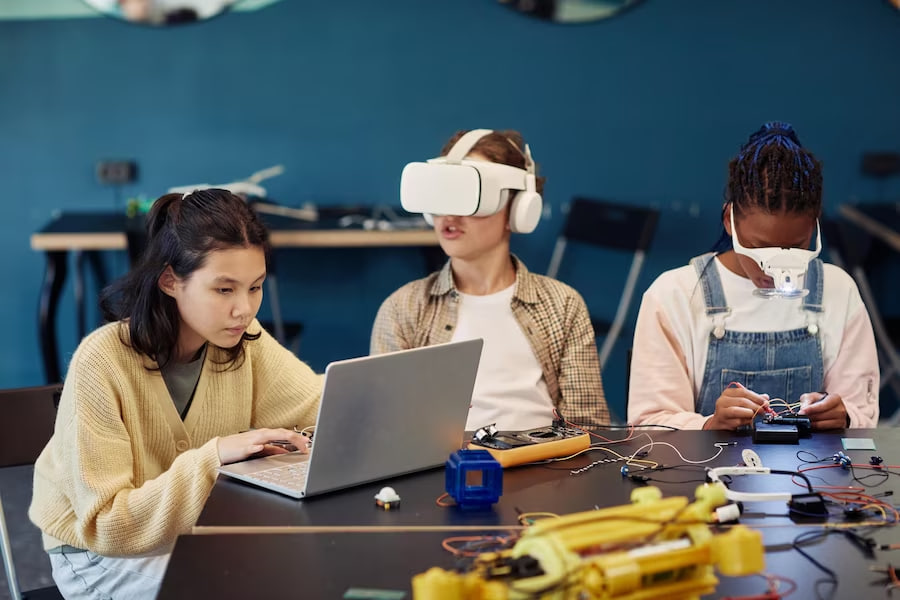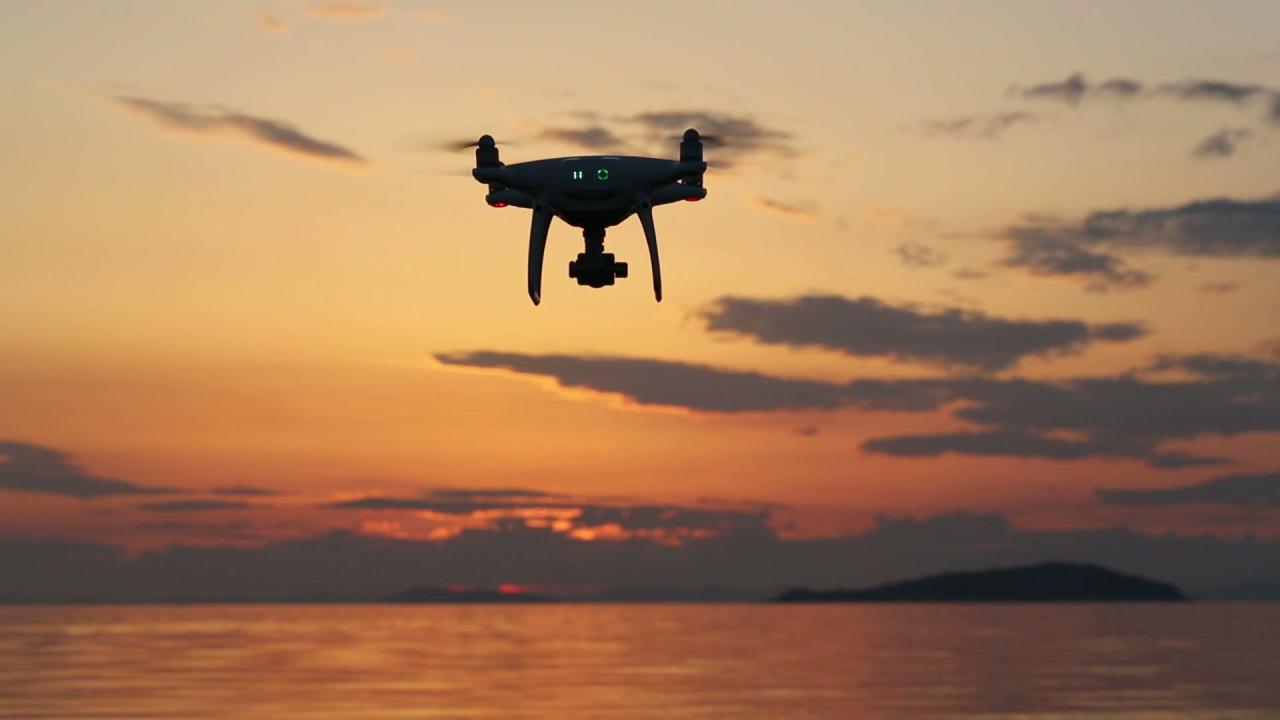Stepping into the Metaverse
Virtual Reality (VR) is no longer a distant dream confined to science fiction novels and futuristic films. It’s a rapidly evolving technology that’s actively reshaping how we interact with digital content, offering immersive experiences that transcend the limitations of traditional screens. By creating simulated environments that can be entirely different from the real world, or even realistic simulations of actual places, VR transports users into new digital realms. This comprehensive article delves deep into the fascinating world of virtual reality, exploring its foundational principles, the diverse array of hardware and software that power it, its ever-expanding applications across various industries, and the profound societal impacts it’s beginning to manifest. We’ll also peer into the future, examining the exciting trends and challenges that lie ahead for this transformative technology.
The Core of Immersion
At its heart, virtual reality aims to trick your senses into believing you are somewhere else. This illusion is achieved through a sophisticated interplay of hardware, software, and a deep understanding of human perception.
A. Head-Mounted Displays (HMDs): The Gateway to Other Realities
The most recognizable component of a VR system is the Head-Mounted Display (HMD). These devices envelop the user’s field of vision, presenting separate images to each eye to create a stereoscopic 3D effect.
- Lenses and Displays: HMDs utilize specialized lenses (e.g., Fresnel lenses) to magnify and correct the image from high-resolution displays (typically LCD or OLED panels). These lenses work in conjunction to create a wide field of view (FOV), making the digital world feel expansive and enveloping. Higher resolution displays with faster refresh rates (e.g., 90Hz, 120Hz) are crucial for reducing the “screen door effect” (where individual pixels are visible) and minimizing motion sickness.
- Tracking Systems: This is perhaps the most critical element for immersion. Tracking systems continuously monitor the user’s head movements, translating them into corresponding movements within the virtual environment.
- Inside-Out Tracking: This is becoming increasingly prevalent. It uses cameras built into the HMD to track the user’s position and orientation relative to their real-world environment. This method is highly convenient as it requires no external sensors. Examples include Meta Quest headsets.
- Outside-In Tracking: This relies on external sensors or “base stations” placed in the physical space to track the HMD and controllers. While often more precise, it requires a more involved setup. Examples include Valve Index and HTC Vive.
- Degrees of Freedom (DoF):
- 3 DoF (Degrees of Freedom): This allows for rotational movement (pitch, yaw, roll) – meaning you can look around in the virtual world. Mobile VR headsets often use 3 DoF.
- 6 DoF (Degrees of Freedom): This provides full positional tracking in addition to rotational movement (x, y, z axes), allowing you to physically move around within the virtual space. This is essential for truly immersive VR experiences. Most standalone and PC VR headsets offer 6 DoF.
B. Input Devices: Interacting with Digital Worlds
To truly feel present in a virtual world, users need intuitive ways to interact with it.
- Hand Controllers: These are the most common input devices, designed to mimic the user’s hands in VR. They often feature buttons, joysticks, and haptic feedback to provide tactile responses to virtual interactions. Advanced controllers can even track individual finger movements.
- Haptic Feedback Systems: Beyond simple vibrations, advanced haptic technology (integrated into controllers, vests, or even full-body suits) can simulate sensations like impacts, textures, and even temperature changes, significantly enhancing immersion.
- Eye Tracking: Increasingly integrated into HMDs, eye-tracking technology allows the VR system to know exactly where the user is looking. This enables:
- Foveated Rendering: A technique that renders the area of the screen you’re directly looking at in high resolution, while peripheral areas are rendered at lower resolution, significantly reducing computational load without compromising perceived visual quality.
- Intuitive Interaction: Users can select objects or navigate menus simply by looking at them.
- Social Presence: Avatars can make eye contact, enhancing realism in social VR experiences.
- Voice Recognition: Integrated microphones and advanced Natural Language Processing (NLP) allow users to issue voice commands, interact with virtual characters, or even type by speaking.
- Motion Capture Suits and Treadmills: For highly specialized applications, full-body motion capture suits can translate every physical movement into the virtual space. Omnidirectional treadmills allow users to walk, run, and move freely in any direction while staying in a fixed physical spot, enhancing locomotion in large virtual environments.
C. Software Platforms and Content Creation: Building the Realities
The hardware is merely the vessel; the software provides the worlds and experiences.
- VR Development Kits (SDKs): Platforms like Unity and Unreal Engine provide robust SDKs for creating VR applications, handling rendering, physics, and interactions.
- VR Operating Systems (OS): Dedicated VR OS (e.g., Meta’s Horizon OS, SteamVR) manage the HMD, controllers, and applications, providing a user interface within VR.
- Content Creation Tools: Specialized tools allow artists and developers to create 3D models, environments, and animations optimized for VR, considering factors like poly count and texture resolution for performance.
- Spatial Audio: Crucial for immersion, spatial audio simulates how sound behaves in a 3D environment, making sounds appear to come from specific directions and distances, enhancing presence and realism.
The Broad Spectrum of VR Applications: Beyond Gaming
While gaming is often the first thing that comes to mind with VR, its applications extend far beyond entertainment, revolutionizing industries and offering new paradigms for learning, working, and social interaction.
A. Entertainment and Gaming: Unparalleled Immersion
VR has revolutionized gaming, offering levels of immersion previously unimaginable.
- Immersive Gaming: From action-packed adventures to intricate puzzle games and social experiences, VR allows players to step directly into game worlds, interacting with them in natural, intuitive ways. Titles like “Half-Life: Alyx” have showcased the potential for deep, narrative-driven VR gaming.
- Virtual Concerts and Events: VR enables users to attend live concerts, sporting events, and theatrical performances from anywhere in the world, often with a sense of presence akin to being there physically.
- Interactive Storytelling: VR provides a new medium for storytelling, allowing users to be participants rather than passive observers, exploring narratives from within.
- Social VR Platforms: Platforms like VRChat and Meta Horizon Worlds allow users to meet, interact, and build communities in virtual spaces, experimenting with digital identities and social dynamics.
B. Education and Training: Experiential Learning Reimagined
VR offers powerful tools for experiential learning, providing safe, repeatable, and highly engaging training environments.
- Medical Training: Surgeons can practice complex procedures in a risk-free virtual operating room. Medical students can explore human anatomy in 3D, gaining a deeper understanding than from textbooks alone.
- Vocational Training: VR simulations can train workers for dangerous jobs (e.g., construction, oil rig operations), allowing them to practice safety protocols and emergency procedures without real-world risk.
- Military and Law Enforcement Training: Soldiers can simulate combat scenarios, and police officers can practice de-escalation techniques in realistic virtual environments.
- Historical and Cultural Immersion: Students can virtually explore ancient civilizations, visit historical landmarks, or experience different cultures firsthand, making learning more memorable and engaging.
- Science Education: Complex scientific concepts, such as molecular structures or planetary systems, can be visualized and manipulated in 3D, aiding comprehension.
C. Architecture, Engineering, and Construction (AEC): Design and Visualization
VR is transforming how professionals in the AEC sector design, visualize, and present their work.
- Virtual Walkthroughs: Architects can create immersive virtual models of buildings and spaces, allowing clients to walk through and experience designs before construction begins, identifying flaws or making changes early on.
- Collaborative Design Reviews: Teams can meet within a virtual environment to collaboratively review 3D models, annotate designs, and make real-time adjustments, even if geographically dispersed.
- Construction Planning: VR can simulate construction processes, helping identify potential logistical issues or safety hazards before they occur on site.
D. Healthcare and Therapy: Healing and Rehabilitation
VR is increasingly being used as a therapeutic tool, offering innovative approaches to mental and physical health.
- Pain Management: VR distractions can help alleviate chronic pain or discomfort during medical procedures by diverting the patient’s attention.
- Phobia Treatment: Exposure therapy can be conducted safely and controllably in VR, helping individuals overcome phobias (e.g., fear of heights, public speaking) in a graded manner.
- Rehabilitation: VR exercises can help patients recover from injuries or strokes by providing engaging and customizable physical therapy routines.
- Mental Health Support: VR can create calming environments for anxiety reduction, or facilitate social skills training for individuals with social anxiety or autism.
E. Retail and E-commerce: Immersive Shopping Experiences
VR is beginning to reshape the retail landscape, offering new ways for consumers to interact with products.
- Virtual Showrooms: Customers can explore virtual car showrooms, view furniture in their homes using AR/VR, or browse clothing on virtual avatars.
- Product Customization: VR allows users to customize products (e.g., cars, homes) in real-time, seeing the changes immediately in a 3D environment.
- Try-Before-You-Buy: While still nascent, the ability to virtually “try on” clothes or experience products before purchase could significantly enhance online shopping.
F. Industrial Design and Prototyping: Iteration and Efficiency
For product designers and engineers, VR accelerates the design cycle and reduces the need for expensive physical prototypes.
- Virtual Prototyping: Designers can create and iterate on 3D models in VR, examining them from all angles, making adjustments, and collaborating with colleagues without building physical mockups.
- Ergonomics Testing: VR allows for testing the ergonomics of a product or workspace, ensuring comfort and efficiency before manufacturing.
- Assembly Training: Complex assembly processes can be simulated in VR, training workers more effectively and reducing errors.
G. Social Connection and Remote Work: The Future of Collaboration
VR is increasingly seen as a platform for enhanced social interaction and collaborative work, especially for remote teams.
- Virtual Meeting Spaces: VR offers more engaging and natural virtual meeting environments than traditional video conferencing, with spatial audio and avatars that can convey non-verbal cues.
- Collaborative Whiteboards and Design: Teams can work together on 3D models, presentations, and creative projects within a shared virtual space.
- Telepresence: More advanced VR systems aim to provide a true sense of telepresence, making remote interactions feel almost as natural as in-person meetings.
Societal Impact of Virtual Reality: Navigating a New Frontier
The widespread adoption of VR carries profound implications for society, touching upon various aspects of our lives.
A. Redefining Presence and Connection
VR’s ability to create a strong sense of presence—the feeling of “being there”—has significant implications for how we connect with others. While it can bridge geographical distances, questions arise about the quality of virtual interactions versus face-to-face encounters. The potential for social VR to create new forms of community and belonging is immense, but also raises concerns about potential social isolation from the physical world.
B. Ethical Considerations and Privacy
As VR becomes more immersive, ethical dilemmas emerge. The collection of highly personal data (e.g., eye movements, body language, emotional responses) raises significant privacy concerns. Issues like virtual harassment, identity theft in the metaverse, and the potential for psychological manipulation within highly realistic virtual environments need careful consideration. Establishing clear ethical guidelines and robust data protection frameworks will be crucial.
C. Psychological Effects and Well-being
The long-term psychological effects of prolonged VR use are still being studied. Concerns include potential addiction, desensitization to violence, cyber sickness (motion sickness in VR), and the impact on perception of reality. Conversely, VR offers therapeutic benefits for anxiety, pain management, and social skills development, highlighting its dual potential. Responsible design and usage guidelines are essential.
D. Economic Transformation and New Industries
VR is creating entirely new industries and job roles, from VR content creators and experience designers to hardware engineers and metaverse architects. It’s also transforming existing sectors, driving innovation and efficiency. The “metaverse” concept, with its virtual economies and digital assets, presents new opportunities for commerce and entrepreneurship, but also raises questions about digital ownership and regulation.
E. Digital Divide and Accessibility
Like any new technology, VR faces the challenge of the “digital divide.” Ensuring equitable access to VR technology and experiences, regardless of socioeconomic status or geographical location, is important to prevent further exacerbating existing inequalities. Furthermore, designing VR experiences that are accessible to individuals with various disabilities is crucial for inclusive development.
Future Trends in Virtual Reality
The future of VR is characterized by continuous evolution, driven by technological breakthroughs and expanding applications.
A. Untethered and Standalone VR: Freedom of Movement
The trend towards standalone VR headsets (e.g., Meta Quest) that don’t require a powerful PC or external wires is paramount. Future devices will be lighter, more comfortable, and offer greater processing power, enabling complex experiences directly on the headset. This untethered freedom makes VR more accessible and convenient for a wider audience.
B. Augmented Reality (AR) Convergence: The Mixed Reality Future
The lines between VR and AR are blurring, leading to Mixed Reality (MR). Future devices will likely seamlessly blend digital content with the real world, allowing users to transition effortlessly between fully immersive VR and augmented reality experiences. This convergence will unlock new possibilities for interaction and productivity, integrating digital information directly into our physical environment.
C. Haptics and Multi-Sensory Immersion: Feeling the Virtual World
Beyond sight and sound, the future of VR will increasingly focus on engaging other senses. Advanced haptic technologies will provide more nuanced and realistic tactile feedback. Research into olfactory (smell) and gustatory (taste) feedback in VR, while challenging, could eventually lead to truly multi-sensory virtual experiences, further enhancing presence.
D. Brain-Computer Interfaces (BCIs): Direct Thought Control
While still largely in the research phase, Brain-Computer Interfaces (BCIs) hold the ultimate promise for direct interaction with virtual worlds. BCIs could allow users to control avatars, manipulate objects, and navigate environments simply with their thoughts, bypassing traditional controllers entirely. This would represent a revolutionary leap in intuitive interaction.
E. Photorealistic Graphics and Cloud Rendering: Unprecedented Visuals
As hardware capabilities advance and cloud computing becomes more powerful, VR experiences will achieve increasingly photorealistic graphics, blurring the line between virtual and real. Cloud rendering for VR could allow even less powerful standalone headsets to render highly complex and detailed environments by offloading the heavy processing to remote servers.
F. AI-Powered Virtual Worlds and Avatars: Intelligent Inhabitants
Artificial intelligence will play an even more significant role in future VR. AI will power more intelligent and responsive non-player characters (NPCs) and virtual assistants, making virtual worlds feel more alive and dynamic. AI could also personalize experiences, generate content on the fly, and create more realistic and expressive avatars.
G. Open Metaverse Standards and Interoperability: A Connected Digital Universe
The concept of the “metaverse” requires interoperability, meaning assets, avatars, and experiences can seamlessly transfer between different virtual platforms. Efforts to establish open standards for VR and metaverse development will be crucial for fostering a truly interconnected digital universe, preventing fragmentation and proprietary walled gardens.
Conclusion
Virtual reality is not merely a technological gimmick; it is a profound paradigm shift that is reshaping industries, redefining human interaction, and offering unprecedented avenues for entertainment, education, and collaboration. From its foundational hardware components that trick our senses to the ever-expanding applications that touch every facet of our lives, VR is a testament to human ingenuity’s boundless potential.
As we stand on the cusp of a more immersive and interconnected digital future, the trajectory of VR points towards lighter, more powerful standalone devices, seamless integration with augmented reality, and richer multi-sensory experiences. However, with this immense potential comes the critical responsibility to address the ethical considerations, privacy concerns, and societal implications that accompany such a transformative technology. By fostering responsible development, prioritizing user well-being, and ensuring equitable access, we can collectively steer the evolution of virtual reality towards a future where new digital worlds enrich and empower all humanity. The journey has just begun, and the new realities awaiting us are limited only by our imagination.

